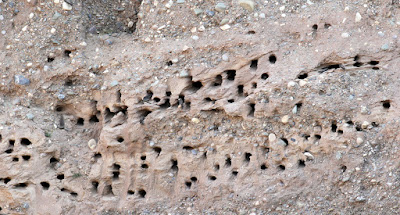I am grateful to my pal who sent me a catalogue of messages from North West Birding Whatsapp. The messages summarise the fun and otherwise surrounding the appearance of a Hoopoe on 27th April 2019.
From Wiki - “The Eurasian Hoopoe is widespread in Europe, Asia, and North Africa and northern Sub-Saharan Africa.”
The Hoopoe is indeed very, very common in the region of the Mediterranean Sea in countries like France and Spain where it can be easily seen in towns, villages, gardens and parks. It is also an annual and regular visitor to the UK, mostly in spring and autumn with sporadic breeding records.
From Whatsapp: To save any embarrassment, names and phone numbers have been omitted from the messages.
April 29th and all seems to be quiet on the Hoopoe front. Welcome to the world of twitching.
Hoopoe
From Wiki - “The Eurasian Hoopoe is widespread in Europe, Asia, and North Africa and northern Sub-Saharan Africa.”
The Hoopoe is indeed very, very common in the region of the Mediterranean Sea in countries like France and Spain where it can be easily seen in towns, villages, gardens and parks. It is also an annual and regular visitor to the UK, mostly in spring and autumn with sporadic breeding records.
Hoopoe
From Whatsapp: To save any embarrassment, names and phone numbers have been omitted from the messages.
- 20:50, 4/27/2019 - Reports on RBA (Rare Bird Alert) of Hoopoe in Charnock Richard at 8.20pm
- 10:48, 4/28/2019 - Hoopoe Charnock Richard. Mate of mine has some great pics just waiting to see where it is.
- 10:50, 4/28/2019 - Location has been taken off the public domain and please not shared due to trespassing on the farmer's land.
- 10:50, 4/28/2019 - Church Lane Charnock Richard.
- 12:39, 4/28/2019 - Hoopoe still present but being disturbed by photographers!!!
- 12:43, 4/28/2019 - Birders or photographers?
- 12:50,4/28/2019 - What a surprise... sounds same as the blyths earlier in the year....
- 12:50, 4/28/2019 - Toggers?
- 12:52, 4/28/2019 - I posted the comment as advice for anyone else visiting, not for discussion. Remember this is a sightings page which I had posted. Thanks.
- 16:01, 4/28/2019 - Any news on hoopoe please
- 16:36, 4/28/2019- Hoopoe in fields on north side of church lane with sheep west of church
- 16:41, 4/28/2019 - Is there somewhere to view from?
- 16:44, 4/28/2019 - There is a small memorial garden. Can be seen by looking through the far trees
- 16:44, 4/28/2019 - Thanks
- 17:29, 4/28/2019 - Hoopoe showing well from private garden Charnock Richard at 17.15
- 17:32, 4/28/2019 - Are we allowed to know where exactly or is that against the owner’s wishes?
- 17:59, 4/28/2019 - I spoke to the young lad from the farm and he said that he had to get the police yesterday as people were refusing to land his field until they got a photo. So guess he's not that happy
- 18:02, 4/28/2019 - Ok, so best not to report it anymore please.
- 18:24, 4/28/2019 - It was the young farmer (Dan) who took me into his garden to see bird. A chap was arrested yesterday for refusing to leave field where pregnant ewes were spooked. His issue is trespassing - not folk birding from footpaths etc.
- 18:31 4/28/2019 - That would be aggravated trespass, which has fine of £200-300 for 1st offence, up to 3 months subsequent offence. And a crim record. Just for a pic
- 18:33, 4/28/2019 - Name and shame the clown.
- 18:34, 4/28/2019 - He's been arrested. That's surely enough? Can we not leave this group for sightings alone?
- 18:35, 4/28/2019 - Here here (sic) zap 😴
- 18:35, 4/28/2019 - Here here (sic)
- 18:38, 4/28/2019 - No further discussion on the Hoopoe in Lancs please. If you decide to go for it please observe the birders (sic) code of conduct the countryside code of conduct and the law.
Hoopoe
April 29th and all seems to be quiet on the Hoopoe front. Welcome to the world of twitching.

























































.jpg)












